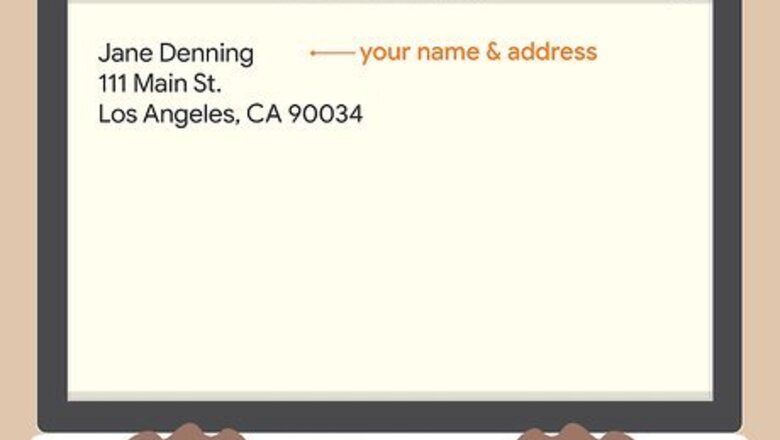
views
- Complete the letter's heading with your name and address, the current date, and the recipient's name and address.
- Make your letter as concise as possible while providing specific deals for the authorization.
- Format the document like a business letter and get a witness or notary's signature.
- Hand over the completed letter to a proxy, but save a copy of the document for yourself.
Writing the Letter’s Heading
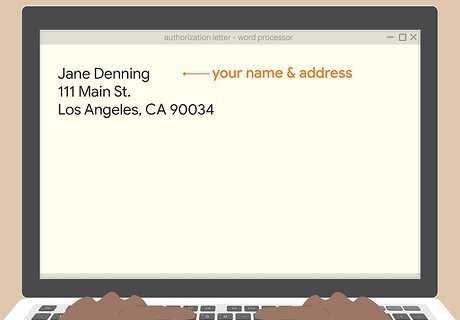
Place your name and address on the top left side of the page. Follow the standard format of a business letter. Your name should be on the first line, your street information on the second line, and your city, state and zip code on the third line. All lines (including those that follow) should be single spaced.
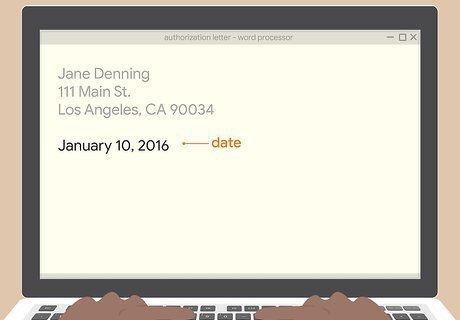
Include the date. After your name and address, skip one line and place the current date on the next line. Write out the full date (such as February 2, 2015, for example). Do not abbreviate the date.
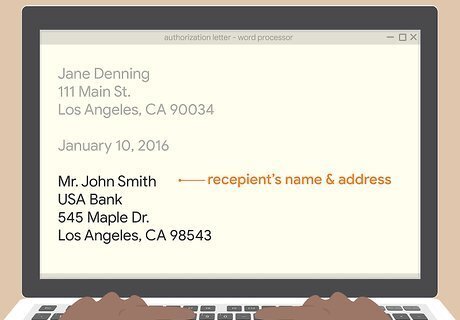
Write the recipient's name and address next. Leave one blank line between the date and first part of the recipient's name and address. The receiver's information should be in the same format as your information. Keep in mind that the recipient is not the same as the one authorized to make decisions for you. You are granting authority to a third party (a proxy) to act on your behalf, but the letter should be addressed to second party (the one with whom you and your proxy are dealing). You may have to leave this portion blank if you do not know the party with which you will be dealing. For example, if you have granted emergency medical powers over your child to a child care worker in case you cannot be reached, you may not know which hospital your proxy will have to deal with.
Writing the Body of the Letter

Write the salutation. Use the appropriate titles, such as "Dr.," "Ms.," "Mrs.," or "Mr.," rather than using first names. The salutation may open with "Dear," or more formally just the word "To." Use the full name and title of the person to whom the letter is addressed. If you do not know the specific name of the party with whom your proxy will be dealing, write "To whom it may concern."

Keep the authorization letter short and precise. Longer letters will include more information that can be interpreted in different ways. Brief letters that specifically address the matter with as little extra verbiage as possible are less likely to lead to conflicting interpretations.
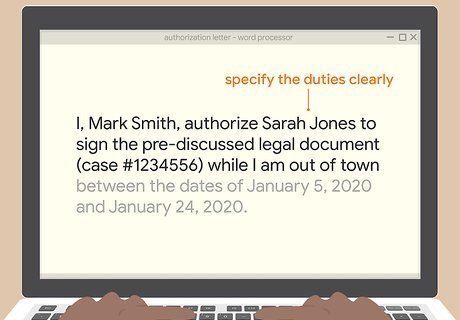
Specify the duties that your representative is authorized to do on your behalf. Make sure your authorization letter is concise and precise. You need to give specific details about the authorization you are granting. For example, your representative can authorize a medical procedure, sign legal documents in your absence, or withdraw funds from your bank. For example, start out the authorization letter with: I, (insert your full name), hereby authorize (insert proxy’s full name) to release to (insert the organization that will receive your medical records), the following medical information from my personal medical records: (list the medical information here). Give very specific details for this authorization. If the letter is regarding your medical information, include your medical insurance number and claim information. If you need assistance regarding a legal matter, include the case number. For financial matters, include the applicable account information.

Give the dates for the authorization. Specify when this authorization is in effect. Give the beginning and ending dates. For example, you might write, “The proxy has authorization to make medical decisions for my child while staying at (address) from September 1, 2015 to September 15, 2015.” In some cases, you may be unsure of the dates, such as if you are authorizing in case of an emergency. For this type of authorization, specify a length of time. For example, you might write, “In the event of an emergency, the proxy has authorization to act on my behalf for 30 days.”
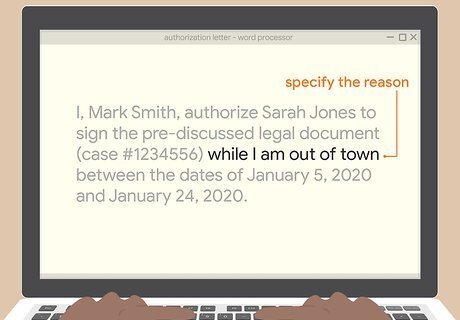
Give the reason for the authorization. Explain why you need a representative to act on your behalf. The explanation might indicate that you are ill, out of town, or may not be able to be reached for certain periods of time.
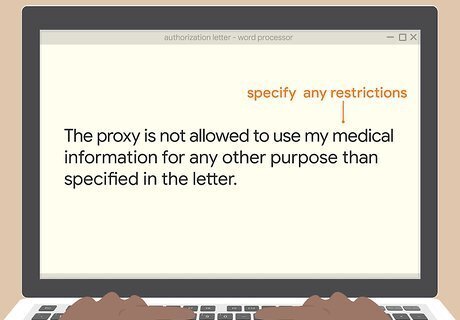
Explain any restrictions on the authorization. You may also want to identify the areas that you are not authorizing. For example, you might say that the proxy is not allowed to use your medical information for any other purpose than specified in the letter. Or, you might say that the proxy is not allowed to make certain financial decisions on your behalf without prior written consent.
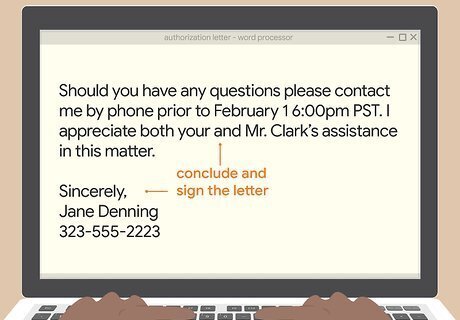
Conclude the letter. Finish up the letter with a closing word such as “Sincerely.” Leave four blank lines, which is where you’ll put your handwritten signature, and then type your full name.
Finalizing the Letter
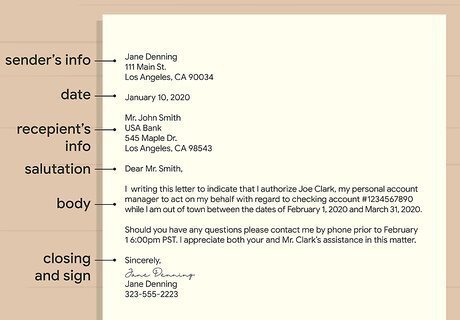
Format the letter properly. A letter of authorization is a business letter and should be formal in tone and format. Standard business letters use a block format. The body should be single-spaced, and there should be no indentation of the paragraphs. Instead a blank line between the salutation and the first paragraph as well as between paragraphs.
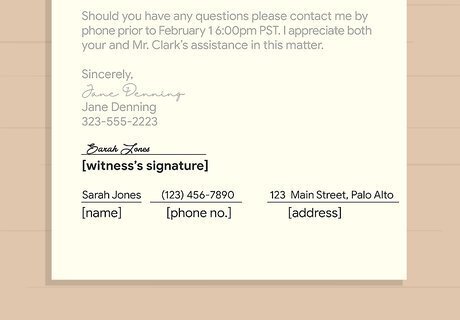
Find a witness or notary public. A witness is someone who will observe you signing the authorization letter. This ensures that you are not signing the letter under duress, and that you are in fact the person giving the authorization. In some instances, it is a good idea to have your letter notarized by a notary public. This person is someone authorized by your state to attest to legal documents. This person should not be anyone named in the letter.

Sign the letter. Print out the letter and sign it with blue or black ink. You may choose to include a date line next to your signature. If so, write the date that you sign the document. Have your witness sign and date the letter as well, or ask the notary public to notarize the letter.
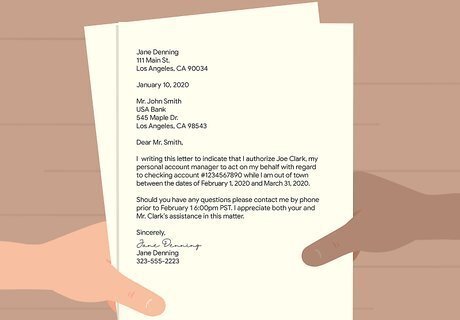
Give the original letter to the proxy. In most cases, the proxy will retain the letter so that he or she has proper documentation of authority granted. The proxy may need to present the letter to immigration officials, for example, if he is traveling internationally with your child.
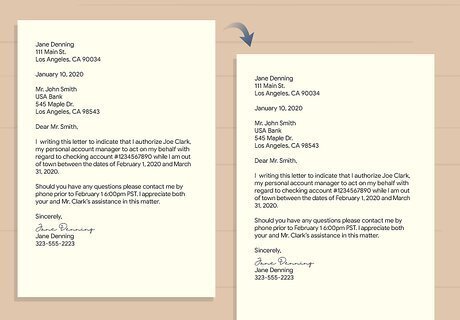
Keep a copy of the letter. Make sure to retain a copy of the letter for your records. You may need to produce it if any questions arise regarding the authorization you’ve given to your proxy.
Preparing to Write an Authorization Letter
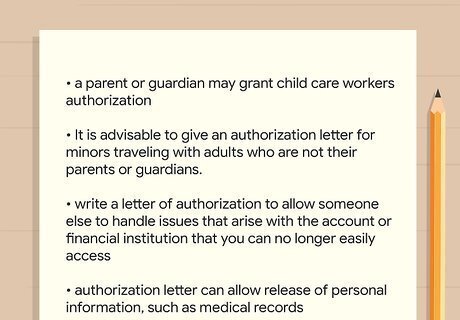
Understand what an authorization letter does. An authorization letter gives another person the right to act on your behalf in specific matters. They are primarily used in circumstances in which the letter writer is not able to represent themselves. A few examples of situations that may require an authorization letter include: A parent or guardian may grant child care workers authorization to make basic emergency medical decisions regarding the children in their care. It is advisable to give an authorization letter for minors traveling with adults who are not their parents or guardians. This will protect the minor from child trafficking and child custody issues. If you have money held in a regional bank that you can no longer easily access, you may need to write a letter of authorization to allow someone else to handle issues that arise with the account or financial institution. An authorization letter can allow release of personal information, such as medical records. You may also need to authorize another party to act on your behalf to handle especially fast-moving financial transactions. Not every business deal can wait for you; if you are temporarily indisposed, you can write a letter of authorization and temporarily grant decision-making powers to a trusted colleague.

Identify the different parties involved in an authorization letter. There are three parties involved in an authorization letter. The first party is the original rights holder, such as the parent of a child or the owner of a bank account. The second party is the group or individual with whom the first party is conducting a transaction, such as a financial institution or hospital. The third party is the person selected to act as a proxy in the first party’s absence. The letter should be addressed to the second party. The letter will explain the rights granted to the proxy who will be acting in your place. If the second party is not known (especially in cases where authority was granted for potential emergency situations), you will have to address the letter simply "To whom it may concern."
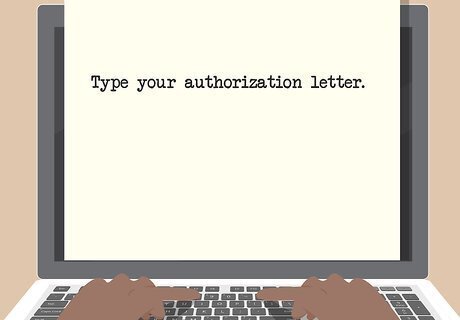
Type your authorization letter rather than writing it by hand. A handwritten letter may be difficult to read and isn't as professional in appearance as a typed letter. The authorization letter is an important document authorizing someone to hold your legal or financial powers for you. It must be prepared to meet scrutiny. If someone else close to you wants to dispute the authority of the letter holder, the document may be used as evidence in a court of law.




















Comments
0 comment